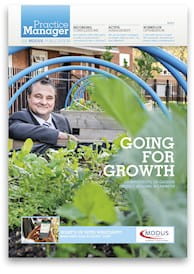ALL across the UK practice managers are feeling the pinch with growing patient lists, reduced resources and staff shortages – this is not exactly news. Neither is the increasing administrative burden faced by GPs.
One practice in Brighton and Hove piloting a scheme to improve the way they process their administrative work found that a “significant number” of letters required no clinical input. Dr Paul Deffley told Pulse Online that he spends approximately 40 minutes each day processing mail, of which 80 per cent could have been dealt with administratively.
New frameworks to help ease GP workloads are being developed at various sites and many include a process known as workflow optimisation or correspondence management. NHS England has identified this as a priority and within the GP Forward View looks to overcome the administrative burden. Correspondence management strategies are intended to encourage practices to train non-clinical staff to process and action practice mail, freeing up GP time to spend on more complex patient issues.
Workflow optimisation has been shown to work but concerns have been raised that the process may in some circumstances be putting patient safety at risk.
NO ACTION REQUIRED
A large proportion of mail received by practices can be identified as 'low risk', with GPs happy for staff to send straight to file with no action required. An example of correspondence requiring no clinical input would be a discharge letter from an accident and emergency department where the patient has attended for a minor injury, such as a sprain or strain, or an acute medical condition such as sore throat. Usually the patient receives sufficient treatment and/or advice that requires no further action for the GP and therefore the letter can be sent straight to the patient’s notes with no further action.
Another potential "low risk" example could be a letter from secondary care informing a GP that a patient did not attend an appointment. This can be frustrating for hospitals with buckling waiting lists but there are many reasons why a patient might fail to attend an appointment. From a risk perspective, it is important to consider the patient as an individual and, in particular, whether they have capacity and fully understand the reason for the referral along with the consequences of not attending – or if they are vulnerable in some way.
A recent call to one of our advisers from a concerned practice manager highlights this issue well. A patient diagnosed with dementia had been referred by a GP for a secondary care opinion, but after the hospital had sent her three offers of appointments with no attendance or response she was discharged back to the GP. A letter detailing the patient’s failure to attend was sent to the GP and this was filed straight into the notes without being highlighted to the doctor.
The patient’s condition deteriorated and it was some months later, when a related acute problem arose, that the GP became aware she had not been reviewed at hospital and had likely disposed of the letters without carers or family being aware. Had the 'DNA' letter been actioned or recorded in a way that highlighted this to the GP, it is likely the patient would have been followed up, preventing a worsening of her condition.
CLEAR GUIDELINES
Workflow optimisation can help provide GPs the time to focus on work that only they can do. But to ensure that new ways of working are safe, it is imperative that practices agree and provide clear guidelines to staff on which patients fall under the umbrella of vulnerability. Indeed, many practices have created ways of flagging these patients so that non-clinical staff can direct mail to the referring GP in order that a clinical view can be taken on the need for follow-up. Vulnerable patients might include:
- children
- older patients who are physically or mentally frail
- patients with learning disabilities
- patients with certain mental health conditions, such as dementia
- the homeless.
Once safe systems are agreed and staff trained, it is important to consider what safety nets the practice could implement to ensure that mail is being correctly actioned. Should there be a GP lead and are practices regularly auditing this activity? One solution adopted by some practices is to nominate a ‘safeguarding officer’ to whom this sort of mail may be directed to follow up with the patient.
Another increasingly common issue in general practice is returned referrals. This can occur for various reasons: the referral may be missing important information or the department may require other tests to be carried out before the patient can be seen. Practices also often see urgent referrals returned with the instruction to resend as a routine referral. A secretary or administrator may follow this instruction with the best intentions, wanting to prevent any further delay. However, these should usually go back to a GP to review (preferably to the original referrer) as they may be aware of further information that requires the patient to be reviewed more urgently.
Practices contacting patients needing bloods or to provide a sample should keep a record of how and when that contact was made. In making such an appointment, a note can be added to say that it was doctor-initiated so that if the patient cancels or DNAs, staff are prompted to make further contact. Good documentation is also key in supporting the clinicians involved, should any medico-legal issues arise as a result of a patient DNA.
A basic incident reporting system should be in place to identify any problems or patterns of concern. The practice manager can then review these to determine whether a significant event analysis (SEA) would be helpful to “tweak” the protocols.
ACTION POINTS
- Identify low-risk correspondence that may have further implications if not reviewed clinically and create a process that safety nets your workflow optimising procedure.
- Ensure non-clinical staff are trained in new processes and are aware of the associated risks and know who to approach for advice if concerned.
- Implement quality assurance of systems to ensure patient safety is not compromised and that staff continue to be competent in delegated tasks.
- GPs should ensure patients are fully informed about the reasons for referral and consequences should they not attend. This discussion should be documented within the record.
- Good documentation will support the clinician in any potential medico-legal issues arising as a consequence of a patient failing to attend for further care.
- When processes are up and running, it is important to ensure that the protocols/policies are reviewed regularly so that any issues arising can be fixed promptly.
Kay Louise Grant is a risk adviser at MDDUS
REFERENCES
- Pulse. How a workflow administrator saved us 40 minutes a day (accessed March 2019)
- NHS England. GP Forward View April 2016
- GMC. Good Medical Practice
This page was correct at the time of publication. Any guidance is intended as general guidance for members only. If you are a member and need specific advice relating to your own circumstances, please contact one of our advisers.
Read more from this issue of Practice Manager

Save this article
Save this article to a list of favourite articles which members can access in their account.
Save to library

